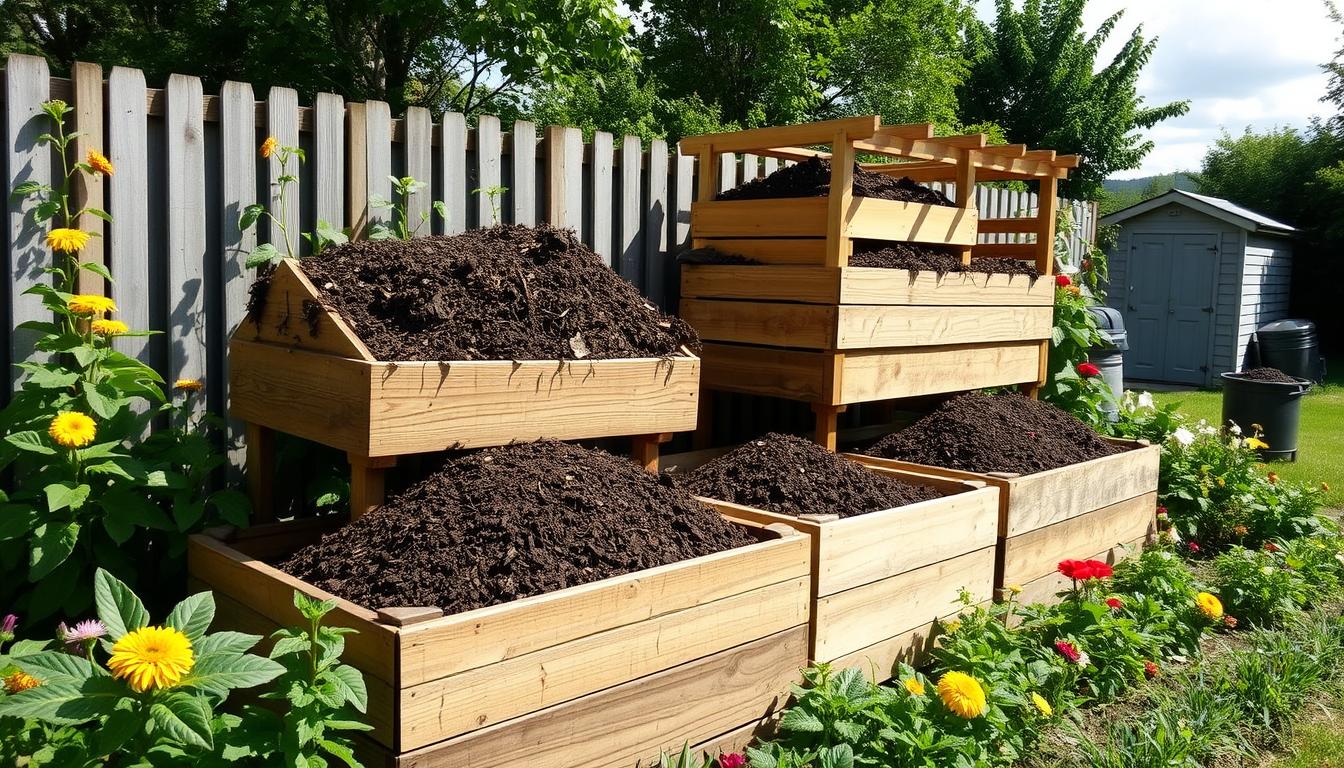Composting transforms organic waste into a valuable resource for gardening, enhancing soil structure and fertility. It’s a natural process that gardeners can use to reduce their environmental impact. This approach is key to creating a sustainable garden ecosystem, vital for garden health. An effective composting system significantly boosts your garden’s health and productivity.
Setting up a compost system is a smart way to recycle organic waste, cut down on landfill waste, and create a nutrient-rich soil amendment. A well-designed composting system fosters a balanced ecosystem, essential for garden health. These systems can be tailored to meet your specific needs and available space, offering a versatile and practical solution for gardeners.
Adopting composting systems can greatly enhance your garden’s health and fertility. This leads to healthier plants, better soil structure, and higher crop yields. Composting is an eco-friendly gardening method that reduces waste, conserves resources, and promotes sustainable practices. These efforts contribute to better garden health.
Key Takeaways
- Composting systems can improve soil structure and fertility, leading to healthier plants and increased crop yields.
- Effective composting systems can reduce waste, conserve resources, and promote sustainable gardening practices.
- A well-designed composting system can help achieve a balanced ecosystem, essential for maintaining garden health.
- Composting is a natural and eco-friendly approach to gardening that reduces environmental footprint.
- Customized composting systems can fit specific needs and available space, making them a practical solution for gardeners.
Understanding the Basics of Composting
Composting is a natural process that breaks down organic waste into a nutrient-rich soil amendment. To begin, gather materials like food scraps, leaves, and grass clippings. These are all examples of organic waste. Place them in compost bins, where they will decompose.
The decomposition process is aided by microorganisms like bacteria and fungi. They feed on the organic matter, breaking it down into simpler compounds. This process can take weeks to months, depending on temperature, moisture, and oxygen levels.
What Makes Good Compost
Good compost combines “green” materials like food scraps and grass clippings with “brown” materials like leaves and twigs. The ideal ratio is 2/3 brown materials to 1/3 green materials. This mix provides the necessary nutrients for microorganisms to break down the organic matter.
The Science Behind Decomposition
The decomposition process involves complex chemical reactions that break down organic matter into simpler compounds. This process releases heat, carbon dioxide, and water vapor. It results in a nutrient-rich compost that enhances soil fertility and structure.
Benefits for Your Garden
Composting offers numerous benefits for your garden. It improves soil fertility and structure, increases crop yields, and reduces synthetic fertilizer needs. It also suppresses plant diseases and pests, enhancing plant health and resilience.
- Improves soil fertility and structure
- Increases crop yields
- Reduces the need for synthetic fertilizers
- Suppresses plant diseases and pests
- Improves the overall health and resilience of your plants
By grasping the basics of composting and using compost bins, you can create a nutrient-rich soil amendment. This will greatly benefit your garden for years to come.
Choosing the Ideal Location for Your Compost System
Setting up a compost system requires proper waste management for success and convenience. The location of your compost system is key for accessibility and odor control. To make sure it enriches your garden, not harms it, consider these factors for the best spot.
A good location should be near a water source but not too close to risk pollution. It should also be easy to reach for upkeep, allowing for regular pile turning and monitoring. Plus, being close to your garden makes transferring the compost easier.
Managing odors and ensuring easy access are crucial. Here are some tips:
- Keep the compost system at least 10 feet from buildings or water sources.
- Regularly turn the compost pile for better aeration and faster decomposition.
- Mix “green” and “brown” materials to keep the carbon-to-nitrogen ratio balanced.
By choosing the right spot for your compost system and following these guidelines, you can create a system that efficiently turns waste into garden nutrients for your plants to flourish.
Essential Materials for Successful Composting
Creating effective composting systems requires the right materials for soil improvement. A balanced mix of green and brown materials is key for efficient decomposition and high-quality compost.
Green Materials (Nitrogen-Rich)
Green materials, like food scraps, grass clippings, and manure, are rich in nitrogen. They speed up decomposition. But, add them in moderation to prevent overheating the compost pile.
Brown Materials (Carbon-Rich)
Brown materials, including dried leaves, straw, and shredded newspaper, are carbon-rich. They balance out green materials. They also absorb excess moisture and prevent odors.
Materials to Avoid
Meat and dairy products should be avoided as they attract pests and cause bad odors. Pet waste and weeds with seeds are also off-limits. They spread diseases and weeds.
Understanding the role of green and brown materials and avoiding unwanted ones is crucial. This way, you can create a balanced composting system. It improves soil and supports healthy plant growth.
Different Types of Composting Systems
Composting offers various systems, each with its own set of benefits and drawbacks. The choice of composting system greatly influences the efficiency of the composting process and the overall garden health. Compost bins are favored for their simplicity and ease of upkeep. Yet, tumblers and worm composters also deserve consideration.
A well-designed composting system fosters a balanced ecosystem. This environment allows microorganisms to flourish, breaking down organic matter efficiently. Such a system promotes healthier plants and a more sustainable garden. Key factors in selecting a system include space, budget, and the materials to be composted. For instance, worm composters excel in small spaces, handling food waste well. Traditional compost bins, on the other hand, are more suitable for larger quantities of yard waste.
- Traditional compost bins: These are the most common type of composting system and are suitable for most gardeners.
- Tumblers: These are great for small spaces and can be used to compost food waste and yard trimmings.
- Worm composters: These are ideal for composting food waste and can be used indoors or outdoors.
By selecting the appropriate composting system, gardeners can cultivate a thriving, sustainable garden ecosystem. This leads to numerous benefits, including enhanced soil structure and increased crop yields.
Building Your Custom Compost Bin
Creating a custom compost bin is key to effective waste management and setting up a composting system that fits your garden. By building your own, you can tailor it to your needs and available space. This ensures it meets your specific requirements.
A well-built compost bin is vital for efficient decomposition and managing odors. You’ll need basic tools like a hammer, nails, and wooden planks to start. You can also repurpose an old pallet or use a wire mesh enclosure for your bin.
Required Tools and Materials
- Hammer and nails
- Wooden planks or an old pallet
- Wire mesh enclosure (optional)
- Air vents and a lid
With the tools and materials ready, you can start building your compost bin. Begin by assembling the frame, then add the wire mesh or wooden planks for the enclosure. Remember to include air vents and a lid for proper ventilation and ease of access.
Step-by-Step Construction Guide
To build your custom compost bin, follow these steps: assemble the frame, add the enclosure, install air vents, and attach a lid. With creativity and basic DIY skills, you can create a functional composting system. It will help you manage waste and produce nutrient-rich compost for your garden.
Maintaining the Perfect Balance in Your Compost
To create top-notch compost, it’s crucial to balance green and brown materials. This balance is key for efficient composting, leading to better soil. Aim for 2/3 brown materials and 1/3 green materials.
It’s important to monitor the compost pile’s mix. Regularly check moisture levels and the carbon-to-nitrogen ratio to adjust as needed. Tips for balance include:
- Adding brown materials like dried leaves or shredded newspaper to increase carbon content
- Incorporating green materials like food scraps or grass clippings to boost nitrogen levels
- Turning the compost pile regularly to ensure adequate aeration and speed up decomposition
By following these tips, you can create nutrient-rich compost. This compost supports healthy plant growth and improves soil.
| Material Type | Carbon-to-Nitrogen Ratio | Examples |
|---|---|---|
| Brown Materials | High Carbon | Dried leaves, shredded newspaper, cardboard |
| Green Materials | High Nitrogen | Food scraps, grass clippings, manure |
Remember, achieving the perfect balance in your compost is key. It leads to a high-quality product that enriches your soil. This supports the growth of healthy plants, improving garden nutrients and soil.
Troubleshooting Common Composting Problems
Composting, though natural, faces challenges like odors, moisture, and pests. These issues can hinder the composting process, making it hard to keep compost bins efficient. Identifying and solving these problems is key to successful composting.
Odors often stem from too much nitrogen or poor aeration. To tackle odors, it’s vital to balance the compost’s carbon-to-nitrogen ratio and ensure good airflow. Adding brown materials, like dried leaves or shredded newspaper, helps absorb moisture and cut down on odors.
Addressing Odor Issues
- Balance the carbon-to-nitrogen ratio
- Ensure proper ventilation in compost bins
- Add brown materials to absorb excess moisture
Managing Moisture Levels
Too much moisture can cause anaerobic conditions, leading to odors and slowing composting. Regularly checking the compost bins and adding brown materials as needed is crucial. This maintains the right moisture levels and supports efficient waste management.
Dealing with Pests
Pests, like rodents or insects, are drawn to compost bins with food waste. To combat pests, using physical barriers, such as hardware cloth or fine-mesh screens, is essential. Regular monitoring and upkeep of the compost bins also help prevent infestations and ensure waste is managed effectively.
| Problem | Cause | Solution |
|---|---|---|
| Odors | Excess nitrogen or inadequate aeration | Balance carbon-to-nitrogen ratio, ensure proper ventilation |
| Excessive moisture | Too much green material or inadequate drainage | Monitor moisture levels, add brown materials as needed |
| Pests | Food waste or inadequate barriers | Use physical barriers, monitor and maintain compost bins regularly |
Harvesting and Using Your Finished Compost
After months of waiting, your compost is now ready to use. Check if it’s dark, crumbly, and has a rich, earthy smell. This means decomposition is complete. Your compost is now a nutrient-rich soil amendment, ready to boost garden health and soil improvement.
Using your compost in the garden offers many benefits. It can improve soil structure, increase water retention, and provide vital nutrients to plants. Here are some ways to utilize your compost:
- Mix it into potting soil for container gardens
- Use it as a top dressing for lawns and gardens
- Incorporate it into seed starting mixes for improved germination and growth
By incorporating your compost, you foster a thriving, sustainable garden ecosystem. This promotes garden health and soil improvement. Use it in moderation to avoid harming your plants. Start with a small amount and gradually increase as needed.
With your finished compost, enjoy a bountiful harvest and a healthy garden. By following these steps and using your compost wisely, you’ll create a sustainable, productive garden. It will provide you with years of enjoyment and fresh produce.
| Compost Use | Benefits |
|---|---|
| Potting soil mix | Improved soil structure and fertility |
| Top dressing | Increased water-holding capacity and nutrient supply |
| Seed starting mix | Enhanced germination and seedling growth |
Conclusion: Embracing Sustainable Garden Practices
Our journey through composting systems reveals its significant impact on garden health. By adopting composting systems, gardeners not only cut down on waste. They also enrich their soil with nutrients, boosting their garden’s vitality.
Composting turns organic waste into a valuable soil amendment. This process improves soil fertility and its ability to retain water. As a result, plants grow stronger, and ecosystems flourish. This reduces the need for harmful chemical fertilizers, promoting a greener environment.
Choosing a simple bin or a more complex system, composting’s advantages are clear. By embracing this eco-friendly method, you contribute to a sustainable future. Your garden and the planet will thank you.


